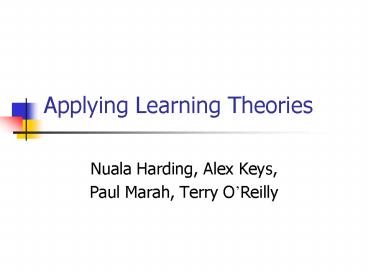Applying Learning Theories - PowerPoint PPT Presentation
1 / 19
Title:
Applying Learning Theories
Description:
Module in e learning on a DIT post grad 3rd Level Learning & Teaching course ... Comfortable with Microsoft Office applications but no experience creating web pages ... – PowerPoint PPT presentation
Number of Views:46
Avg rating:3.0/5.0
Title: Applying Learning Theories
1
Applying Learning Theories
- Nuala Harding, Alex Keys,
- Paul Marah, Terry OReilly
2
Where we came from
- Module in e learning on a DIT post grad 3rd Level
Learning Teaching course - Practising lecturers
- Aware of learning theories
- Comfortable with Microsoft Office applications
but no experience creating web pages
3
Knowledge of Computers
4
What was expected
- Develop an e learning course and launch it on the
DIT intranet within 8 weeks - Produce a group report justifying the e
learning course from an educational point of view
5
Theories of Learning Timeline
6
Starting point
- Pick a traditional course module (Computer
studies for 1st year Engineering students) - Brainstorm the new Rationale and Course
Philosophy - Finalise the Module Descriptor
7
Proposed Course Outline
- Existing module consists of two semesters of a
classroom based computer course - The first semester is to remain untouched but the
second semester will now be provided by e
learning - The rationale is to develop the students
computer skills while pursuing Professional
Development skills
8
Keeping the focus
- The student
The course rationale
The course philosophy
The student
The module descriptor
9
Behaviourism
- The module has to have learning outcomes for the
student, the lecturer and the overall course
structure. - These include demonstrating teamwork skills,
collaboration using on-line communications and
developing independent learning skills - These are listed on the course Introduction/Module
Description web page
10
Humanism
- One of the weekly tasks required of the student
on-line is to research and champion an engineer
from their locality - This would develope self learning skills, provide
self motivation and could lead to belongingness
and peer esteem (Maslows Hierarchy of Needs)
11
Cognitivism
- Dingbats are juxtaposition text images
- Students are required on-line and in small groups
to interpret these and develop new dingbats - This will stimulate mental imagery while aiding
problem solving and decision making - It allows reorganisation of the cognitive
structures which humans use to process and store
information (Good Brophy, 1990)
12
Sample Dingbats
Man ---------- Board
- Ground
- --------
- Feet
- Feet
- Feet
- Feet
- Feet
- Feet
13
Social Learning
- The earlier task of championing a local engineer
is followed by group discussions about the role
of the engineer in society. The emphases is in
the students perception of the role and their
reason for choosing this career path. - This group interaction links the students and
society and involves interaction and mutual
influence (Jarvis, 2003)
14
Constructivism
- Learning is a process of making meaning
- What is learnt will depend on the students
interests and whether the process....is primary
individual or social (Merriam Cafarella 1999) - The students are encouraged to direct the weekly
tasks and reflect on their effectiveness
15
Home Page
16
Introduction Page
17
Communications
18
Resources Page
19
Learning not Technology































